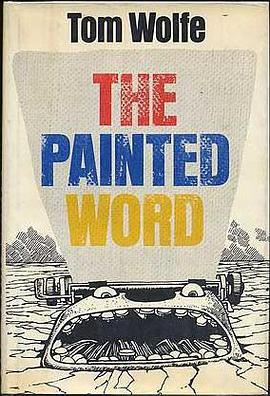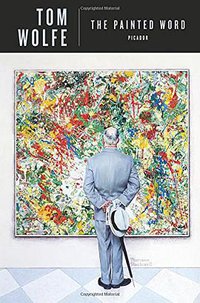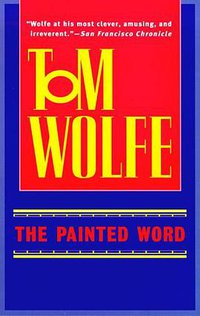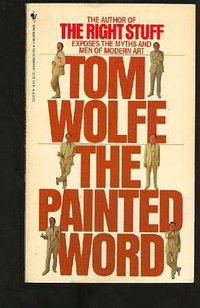The Painted Word
豆瓣
[美国] 汤姆·沃尔夫
简介
In 1975, after having put radical chic and '60s counterculture to the satirical torch, Tom Wolfe turned his attention to the contemporary art world. The patron saint (and resident imp) of New Journalism couldn't have asked for a better subject. Here was a hotbed of pretension, nitwit theorizing, social climbing, and money, money, money--all Wolfe had to do was sharpen his tools and get to work. He did! Much of The Painted Word is a superb burlesque on that modern mating ritual whereby artists get to despise their middle-class audience and accommodate it at the same time. The painter, Wolfe writes, "had to dedicate himself to the quirky god Avant-Garde. He had to keep one devout eye peeled for the new edge on the blade of the wedge of the head on the latest pick thrust of the newest exploratory probe of this fall's avant-garde Breakthrough of the Century.... At the same time he had to keep his other eye cocked to see if anyone in le monde was watching."
The other bone Wolfe has to pick is with the proliferation of art theory, particularly the sort purveyed by postwar colossi like Harold Rosenberg, Clement Greenberg, and Leo Steinberg. Decades after the heyday of abstract expressionism, these guys make pretty easy targets. What could be more absurd, after all, than endless Jesuitical disputes about the flatness of the picture plane? So most of them get a highly comical spanking from the author. It's worth pointing out, of course, that Wolfe paints with a broad (as it were) brush. If he's skewering the entire army of artistic pretenders in a single go, there's no room to admit that Jasper Johns or Willem DeKooning might actually have some talent. But as he would no doubt admit, The Painted Word isn't about the history of art. It's about the history of taste and middlebrow acquisition--and nobody has chronicled these two topics as hilariously or accurately as Tom Wolfe.
★★★★★
The Painted Word charts the erratic course of the social history of Modern Art from its beginnings in revolution-a revolution against literary content in art-to its present state, in which it has become, quite unconsciously, a parody of itself, obsessedly devoted to the pronouncements of certain guru-critics, to the point of reductio ad absurdum, to the point where-turnabout being fair play-it has become as literary, as academic, as mannered, as clubby, as the salon painting against which it first rebelled.
Soon after Modern Art developed, it became fashionable. Society (le beau monde, Cultureburg) and art critics attached themselves to it like pilot fish; but then they grew, and grew, and grew, until-as Abstract Expressionism gave way to Pop, as Pop spawned Op, as Op fell before Minimal opposition, as what was Minimal became no more than Conceptual-Art began to serve fashion and theory. The shark vanished and left the pond to le beau monde and to the critics, custodians of the painted Word. Clement Greenberg, Harold Rosenberg, Leo Steinberg-these are the big fish, Wolfe argues, not Jackson Pollock, Willem de Kooning, or Jasper Johns. The argument is utterly convincing . . .
. . . and wildly entertaining. Tom Wolfe is our premier social historian, and he is writing at the top of his form. Whether he is describing the Art Mating Ritual (in two parts, the Boho Dance and the Consummation) or taking the census of Cultureburg, he writes with an energy and irony all his own. His style has never been more dazzling, his wit has never been more keen. For everyone but his targets, the publication of The Painted Word is cause for celebration.
★★★★★
"He satirizes with such devastating accuracy the process by which the modern-art world affirmed its theoreticians." -Christopher Lehmann-Haupt, The New York Times
"If you have ever stared uncomprehendingly at an abstract painting that admired critics have said you ought to dig, take heart. Tom Wolfe . . . is on your side. The Painted Word may enrage you. It may confirm your darkest suspicions about Modern Art. In any case, it will amuse you."--New York Sunday News
"Tom Wolfe is a journalist who always manages to combine an encyclopedic store of inside knowledge with the obstinate detachment of a visitor from Mars, not to mention a brilliant style and incisive wit."--San Francsico Chronicle
"The Painted Word may well be Tom Wolfe's most successful piece of social criticism to date."--The New York Times
"The Painted Word is a masterpiece. No one in the art world . . . could fail to recognize its essential truth. I read it four times, each of them with mounting envy for Wolfe's eye, ear, and surgical skill."--The Washington Post
"His eye and ear for detailed observations are incomparable; and observation is to the satirist what bullets are to a gun."--The Boston Sunday Globe
contents
1. The apache dance
2. The public is not invited (and never has been)
3. Le Tout New York on a Cubist horse
4. Greenberg, Rosenberg & Flat
5. Hello, Steinberg
(Goodbye, Greenberg)
(You, too, Rosenberg)
(Joy returns to Cultureburg)
6. Up the fundamental aperture
Epilogue



